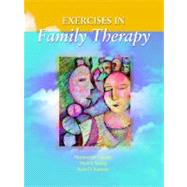Exercises in Family Therapy

Exercises in Family Therapy
- ISBN 13:
9780130620002
- ISBN 10:
0130620009
- Edition: 1st
- Format: Paperback
- Copyright: 08/17/2001
- Publisher: Pearson
Note: Supplemental materials are not guaranteed with Rental or Used book purchases.
Extend or Purchase Your Rental at Any Time
Need to keep your rental past your due date? At any time before your due date you can extend or purchase your rental through your account.
Summary
Welcome to Exercises in Family Therapy. This study guide was developed to help you apply theories and concepts in Family Therapy: History, Theory, and Practice, Third Edition, by Samuel T. Gladding. The study guide has 16 chapters, each corresponding to the same-numbered chapter in Gladding's text, an appendix, and a glossary. Each chapter in the study guide has a chapter overview, key terms, activities, questions for class discussion and small-group work, questions for personal growth, and a self-assessment quiz. We recommend that you read the chapter in the text before responding to the exercises in the study guide. You will find that when you do so, this study guide will facilitate your learning of the textbook material. You will also have the opportunity to reflect on what you have learned and share your learning with fellow students. These exercises were developed to clarify material as well as help you study important information that could be used later in a test or even as a way to prepare for state licensure or certificate exams.
Chapter Overview
Each chapter begins with a chapter overview. This overview provides a summary of the ideas discussed in the textbook, as well as key theorists, historical events, and important concepts. You can also use this overview as a way to review the material prior to going to class or taking a quiz.
Key Terms
The key terms section provides a listing of new family therapy words appearing in each chapter. As you learn about a particular theory, you will find that each has a special language. Knowing these specific terms can be helpful as you try to differentiate specific family dynamics and theoretical approaches and understand specific populations. Make a check mark next to those terms that are unfamiliar when you are going through the study guide chapters. Later, you can look up the definitions in the glossary that appears at the end of this study guide.
Activities
The activity section contains a case study followed by questions that ask you to apply your learning and clinical skills to the family that is described. Issues of diversity are emphasized in these case studies as a way to help you understand the complex issues that families bring to therapy and to expose you to the various configurations that families may take.
Questions for Class Discussion and Small-Group Work
The questions in this section are designed to stimulate group discussions in the classroom as well as provide opportunities for you to share ideas with each other. Frequently, this section allows for more than one correct answer as well as opportunities for understanding one's personal attitudes towards a topic. It is suggested that you jot down your reactions and thoughts on these questions as preparation for your in-class discussions.
Questions for Personal Reflection
Each chapter in this guide contains a section called "Questions for Personal Reflection." These questions provide an opportunity for you to focus on personal growth and develop the art of reflection. Before working with families and becoming an effective therapist, it is important that you explore your own family issues. You have the opportunity in this section to think about your reactions to the material in as much depth as you wish. You may also want to keep a journal using these questions as journal starters. We have found that a course in family therapy can trigger unexpected emotions, and it can be an important learning experience if you address these issues as they arise.
Self-Assessment Quiz
The self-assessment quiz contains both true/false and multiple choice questions. Both types of questions give you feedback about how well you have understood the textbook material. The quiz will help you assess your areas of strength and comprehension and identify areas that need further review and study. You are encouraged to read each question thoroughly, consider all the possible answers, and then choose the "best" answer in each instance.
Appendix
The appendix contains the answers to the true/false and multiple choice questions. As you evaluate your answers, pay attention to those questions you answer correctly, but also take note of those you answer incorrectly. Frequently, wrong answers provide a clue to areas of material you have missed and provide opportunities for further learning.
Glossary
The study guide also includes the glossary from Family Therapy: History, Theory, and Practice, Third Edition. We have reprinted the glossary to make it more convenient when you run across an unfamiliar term.
Give Us Feedback
We wish you the very best as you enter this exciting journey of learning about marriage and family therapy—its history, its theory, and its practice. If you have any ideas how to improve this study guide and would like to share them with us, we welcome your feedback. Please send your thoughts and reactions to Montserrat Casado at this address: mcasado@mail.ucf.edu
Montserrat Casado
Mark E. Young
Scott D. Rasmus






